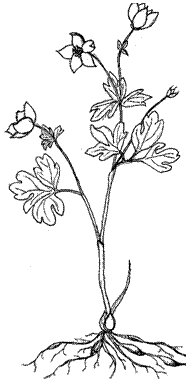False-rue anemone COSEWIC assessment and status report: chapter 3
Species Information
Name and classification
Scientific name
Enemion biternatum Raf.
Pertinent synonyms
Isopyrum biternatum (Raf.) Torr. & Gray
Common names
False rue-anemone, Eastern false rue-anemone, False meadow-rue
Family name
Ranunculaceae (Buttercup family)
Major plant group
Dicot flowering plant
Enemion biternatum is the only member of the genus represented in central and eastern North America. Three other species of Enemion are native to the Pacific coast of North America (Gleason, 1991) and one species (E. savilei) is endemic to the Queen Charlotte Islands (Calder and Taylor, 1963).
Enemion is thought to refer to the Greek term anemos, which means wind; biternatum is Latin for "twice in sets of three" referring to the leaves and the leaflet subdivisions. Enemion biternatum is commonly called false rue-anemone because the flower is almost indistinguishable from the native rue-anemone, Thalictrum thalictroides (Anemonella thalictroides; see NHIC, 2002).
Description
Enemion biternatum is a spring flowering perennial that grows from 10-40 cm high. Stems are ribbed and smooth originating from a tuberous rootstock. Roots are slender and swollen at intervals to form tiny tubers (Wherry, 1948). Stem leaves are short petioled (1 mm) or sessile, usually biternate but occasionally the uppermost stem leaves are trifoliate. Basal leaves are biternate, rarely triternate, with long petioles, up to 15 cm. Leaflets are 4-18 mm long, 2-14 mm wide, and usually 2-3 lobed (occasionally entire or five lobed) with shallow deep sinuses. Leaflet lobes are round to acute tipped. Leaflets are glabrous and darker green above. The compound leaves are subdivided, usually, into 3 groups, of 3 leaflets each. Leaflets normally have 3 lobes, but may have more. The leaves attach individually, and emerge both from the base of the plant, on long petioles, and from the upper parts of the stem, on short petioles. Involucral leaves occur immediately below the flowers, may attach directly without petioles, and have only 3 leaflets. Stipule-like projections occur where the petioles join the stem.
Enemion biternatum flowers are small and delicate, lack true petals but have 5 white, obovate, petal-like sepals, surrounding a cluster of stamens with yellow anthers. Stems may divide into two or more branches, each with a single flower. Flowers are 1.5-2 cm wide and are borne singly in leaf axils or at the end of stems. Flowers are bisexual. The petal-like sepals are 4-10 mm long, 3-8 mm wide. The stamens typically surround 4 leaf-like pistils that terminate in tiny, thread-like styles.Follicles are divergent, greenish to tan, glabrous and somewhat compressed (Mitchell and Dean, 1982). Seeds are smooth.
Figure 1. Illustration of Enemion biternatum (by M. Thompson)

This species is sometimes confused with a close relative, the rue-anemone (Thalictrum thalictroides), but rue-anemone generally occurs in drier woodlands and is more common under oaks than maples (NHIC, 2002). Superficially, Enemion biternatum resembles Thalictrum thalictroides in the division of its leaves and its delicate white flowers. However, Enemion biternatum can be distinguished from T. thalictroides by the following:
Enemion biternatum
Thalictru thalictroides
Enemion biternatum could also be confused with Thalictrum species on the basis of vegetative characteristics, particularly Thalictrum dioicum, which is also a spring ephemeral. Enemion biternatum has more deeply lobed leaflets, a more reddish stem (in Ontario populations at least), brighter green leaves and a different flower structure (Austen, 1990).